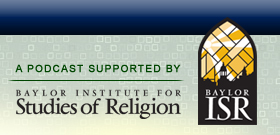

|
Shari Rabin on Jews on the American Frontier  Date: March 11th, 2018
 What is it like to be a stranger in a strange land on the move, and how does that affect one’s ability to preserve their religious identity? This is a central question take up by Prof. Shari Rabin, an assistant professor of Jewish Studies at the College of Charleston and director of the Pearlstine/Lipov Center for Southern Jewish Culture, in her new book Jews on the Frontier: Religion and Mobility in Nineteenth-Century America. We begin, as usual, with a little background on our guest, learning how Prof. Rabin moved from Wisconsin to Georgia and then into the study of Jewish migration. Not surprisingly, we learn that her research interests in graduate school resonated with her own experiences on the move. Shari also gives us a synopsis of the Peralstine/Lipov Center that she runs. We then move into our discussion on Jewish migration in 19th century America, first with a general overview of Jewish migration patterns dating back to the early colonial period in America. We learn that Charleston actually has the second oldest synagogue in the US dating back to the mid-17th century. Our conversation covers the various “push” and “pull” factors that led many Jews to migrate to American in the early 1800s. In Europe, governments tightly regulated Jewish behavior and living patterns, which served to shape their communities. In the US, by contrast, no such regulations existed and with the opportunity to head out West, it became very easy for one to lose one’s religious identity. The struggle to retain one’s heritage serves to focus the rest of our discussion. It is noted that much of the early Jewish migration was comprised of single males, making it difficult to find a spouse and raise a Jewish family. Intermarriage with Christians always presented itself as one possibility, but there were efforts to provide Jewish matchmaking services in order to retain cultural continuity. Issues of circumcision are also discussed, with Prof. Rabin noting that it was very difficult to find someone qualified to perform the procedure within the required eight days of birth. This, in turn, led to some creative flexibility on the part of Jews who needed to bend the strict rules. Other challenges facing Jews on the move related to finding Jewish “stuff,” such as kosher food, Torah scrolls, prayer shawls, and other elements of the faith that were used on a daily basis. And setting up a synagogue that helped to reinforce communal worship was also difficult as in some communities it was difficult to gather a quorum of believers to establish the congregation. The final part of our conversation relates to how Jewish theology responded to the physical challenges of living as a minority in mobile times. Shari discusses two central figures in American Jewish history who were aware of these challenges and sought to shape religious identity to the new circumstances — Isaac Mayer Wise and Isaac Leeser. The former was a central figure in the creation of Reform Judaism, whereas the latter tried to preserve more traditional forms of Judaism. Despite their seemingly divergent approaches, Shari points out that these two religious entrepreneurs also shared much in common, using newspapers as a means of communication within the American Jewish community. She notes that the newspapers were not only there to broadcast to Jews the changes in Jewish culture that were occurring, but as Jews wrote into the paper describing their daily challenges, these men were able to keep their “ears to the ground” of the culture and diagnose the problems of the faithful. Their answers to these challenges often led to expanding notions of cultural authenticity, demonstrating that theology can be very flexible to one’s contextual environment. Shari also reveals that because Wise outlived Leeser by nearly three decades, he had a larger imprint on the nature of American Jewish culture. We sum up our discussion with the importance of the year 1877 and two important events. First Isaac Wise’s trip to California led him to write a series of travel letters that indicated his awe of how vibrant the Jewish culture remained in new lands, but also how he was concerned about how some changes (such as intermarriage with Christians) was threatening the long-term viability of the faith. The second major event of that year was the Seligman Affair, wherein a prominent Jewish businessman was prohibited from obtaining lodging in Saratoga, New York. This latter incident revealed that up until that time, Jewish life in American was largely individualistic and invisible, but as the population started to grow and find ways to enhance their communal relationships it often brought with it anti-Semitism and other forms of negative attention. We end the podcast with Prof. Rabin’s thoughts on what she has learned throughout her studies of Jewish life and migration. Recorded: February 23, 2018. RELATED LINKS Prof. Shari Rabin’s bio at the Pearlstine/Lipov Center for Southern Jewish Culture at the College of Charleston. Prof. Rabin’s personal website (with links to her various writings). Jews on the Frontier: Religion and Mobility in Nineteenth-Century America, by Shari Rabin. The American Israelite, the newspaper founded by Isaac Mayer Wise (originally named The Israelite). RELATED LINKS Colleen Haight on Jewish Peddlers in 19th Century America. Carmel Chiswick on the Economics of Being Jewish in America. Carmel Chiswick on the Economics of American Judaism (different than episode listed above). Daniel Libenson on Present and Future Judaism. Ken Wald on the Puzzling Politics of American Judaism. Linda Weiser Friedman on Jewish Humor. Click out “Jewish” category on the right hand side of our website for more episodes related to Judaism.
One Response to “Shari Rabin on Jews on the American Frontier”Leave a Reply |
 Search The Podcast
To search the podcast, type a term and click the Search button.
  Browse Podcast Categories
Select a category below to browse the podcast:
   |















[…] Shari Rabin on Jews on the American Frontier. […]